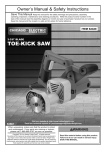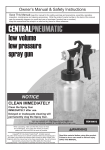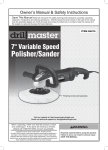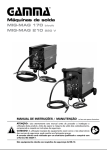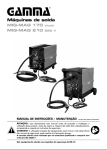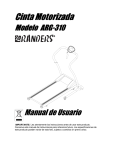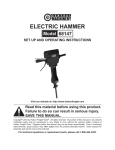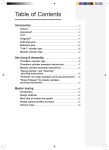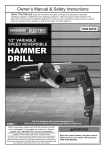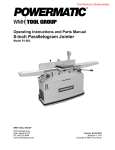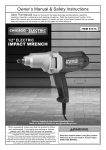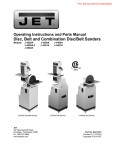Download Harbor Freight Tools 5_3/8 in. 5.9 Amp Heavy Duty Metal Cutting Circular Saw Product manual
Transcript
Owner’s Manual & Safety Instructions Save This Manual Keep this manual for the safety warnings and precautions, assembly, operating, inspection, maintenance and cleaning procedures. Write the product’s serial number in the back of the manual near the assembly diagram (or month and year of purchase if product has no number). Keep this manual and the receipt in a safe and dry place for future reference. ITEM 69702 5-3/8" METAL CUTTING CIRCULAR SAW Visit our website at: http://www.harborfreight.com Email our technical support at: [email protected] When unpacking, make sure that the product is intact and undamaged. If any parts are missing or broken, please call 1-800-444-3353 as soon as possible. Copyright© 2012 by Harbor Freight Tools®. All rights reserved. No portion of this manual or any artwork contained herein may be reproduced in any shape or form without the express written consent of Harbor Freight Tools. Diagrams within this manual may not be drawn proportionally. Due to continuing improvements, actual product may differ slightly from the product described herein. Tools required for assembly and service may not be included. Read this material before using this product. Failure to do so can result in serious injury. SAVE THIS MANUAL. Table of Contents Safety Safetye��������������������������������������������������������� 2 Specifications.............................................. 9 Setup........................................................... 9 Operationa��������������������������������������������������� 10 Maintenancei���������������������������������������������� 12 Parts List and Diagram............................... 14 Warranty..................................................... 16 WARNING SYMBOLS AND DEFINITIONS Setup This is the safety alert symbol. It is used to alert you to potential personal injury hazards. Obey all safety messages that follow this symbol to avoid possible injury or death. Indicates a hazardous situation which, if not avoided, will result in death or serious injury. Indicates a hazardous situation which, if not avoided, could result in death or serious injury. Indicates a hazardous situation which, if not avoided, could result in minor or moderate injury. Addresses practices not related to personal injury. Operation IMPORTANT SAFETY INFORMATION General Power Tool Safety Warnings Read all safety warnings and instructions. Failure to follow the warnings and instructions may result in electric shock, fire and/or serious injury. Save all warnings and instructions for future reference. The term ″power tool″ in the warnings refers to your mains-operated (corded) power tool. Maintenance Work area safety 1. Keep work area clean and well lit. Cluttered or dark areas invite accidents. 2. Do not operate power tools in explosive atmospheres, such as in the presence of flammable liquids, gases or dust. Power tools create sparks which may ignite the dust or fumes. Page 2 3. Keep children and bystanders away while operating a power tool. Distractions can cause you to lose control. For technical questions, please call 1-800-444-3353. Item 69702 1. Power tool plugs must match the outlet. Never modify the plug in any way. Do not use any adapter plugs with grounded power tools. Unmodified plugs and matching outlets will reduce risk of electric shock. 4. Do not abuse the cord. Never use the cord for carrying, pulling or unplugging the power tool. Keep cord away from heat, oil, sharp edges or moving parts. Damaged or entangled cords increase the risk of electric shock. 2. Avoid body contact with grounded surfaces such as pipes, radiators, ranges and refrigerators. There is an increased risk of electric shock if your body is grounded. 5. When operating a power tool outdoors, use an extension cord suitable for outdoor use. Use of a cord suitable for outdoor use reduces the risk of electric shock. 3. Do not expose power tools to rain or wet conditions. Water entering a power tool will increase the risk of electric shock. 6. If operating a power tool in a damp location is unavoidable, use a Ground Fault Circuit Interrupter (GFCI) protected supply. Use of a GFCI reduces the risk of electric shock. Safety Electrical safety 2. Use personal protective equipment. Always wear eye protection. Safety equipment such as dust mask, non-skid safety shoes, hard hat, or hearing protection used for appropriate conditions will reduce personal injuries. 3. Prevent unintentional starting. Ensure the Trigger is in the off‑position before connecting to power source, picking up or carrying the tool. Carrying power tools with your finger on the Trigger or energizing power tools that have the Trigger on invites accidents. 4. Remove any adjusting key or wrench before turning the power tool on. A wrench or a key left attached to a rotating part of the power tool may result in personal injury. 5. Do not overreach. Keep proper footing and balance at all times. This enables better control of the power tool in unexpected situations. 6. Dress properly. Do not wear loose clothing or jewelry. Keep your hair, clothing and gloves away from moving parts. Loose clothes, jewelry or long hair can be caught in moving parts. 7. If devices are provided for the connection of dust extraction and collection facilities, ensure these are connected and properly used. Use of these devices can reduce dust‑related hazards. 8. Only use safety equipment that has been approved by an appropriate standards agency. Unapproved safety equipment may not provide adequate protection. Eye protection must be ANSI‑approved and breathing protection must be NIOSH‑approved for the specific hazards in the work area. Operation 1. Stay alert, watch what you are doing and use common sense when operating a power tool. Do not use a power tool while you are tired or under the influence of drugs, alcohol or medication. A moment of inattention while operating power tools may result in serious personal injury. Setup Personal safety 1. Do not force the power tool. Use the correct power tool for your application. The correct power tool will do the job better and safer at the rate for which it was designed. 2. Do not use the power tool if the Trigger does not turn it on and off. Any power tool that cannot be controlled with the Trigger is dangerous and must be repaired. 3. Disconnect the plug from the power source before making any adjustments, changing accessories, or storing power tools. Such preventive safety measures reduce the risk of starting the power tool accidentally. Item 69702 4. Store idle power tools out of the reach of children and do not allow persons unfamiliar with the power tool or these instructions to operate the power tool. Power tools are dangerous in the hands of untrained users. 5. Maintain power tools. Check for misalignment or binding of moving parts, breakage of parts and any other condition that may affect the power tool’s operation. If damaged, have the power tool repaired before use. Many accidents are caused by poorly maintained power tools. For technical questions, please call 1-800-444-3353. Page 3 Maintenance Power tool use and care 6. Keep cutting tools sharp and clean. Properly maintained cutting tools with sharp cutting edges are less likely to bind and are easier to control. 7. Use the power tool, accessories and tool bits etc. in accordance with these instructions, taking into account the working conditions and the work to be performed. Use of the power tool for operations different from those intended could result in a hazardous situation. Safety Service Have your power tool serviced by a qualified repair person using only identical replacement parts. This will ensure that the safety of the power tool is maintained. Circular Saw Safety Warnings 1. DANGER: Keep hands away from cutting area and the blade. Keep your second hand on auxiliary handle, or motor housing. If both hands are holding the saw, they cannot be cut by the blade. Setup 2. Do not reach underneath the workpiece. The guard cannot protect you from the blade below the workpiece. 3. Adjust the cutting depth to the thickness of the workpiece. Less than a full tooth of the blade teeth should be visible below the workpiece. 4. Never hold piece being cut in your hands or across your leg. Secure the workpiece to a stable platform. It is important to support the work properly to minimize body exposure, blade binding, or loss of control. Operation 5. Hold power tool by insulated gripping surfaces when performing an operation where the cutting tool may contact hidden wiring or its own cord. Contact with a ″live″ wire will also make exposed metal parts of the power tool ″live″ and shock the operator. 6. When ripping always use a rip fence or straight edge guide. This improves the accuracy of cut and reduces the chance of blade binding. 7. Always use blades with correct size and shape (diamond versus round) of arbor holes. Blades that do not match the mounting hardware of the saw will run eccentrically, causing loss of control. Maintenance 8. Never use damaged or incorrect blade washers or bolt. The blade washers and bolt were specially designed for your saw, for optimum performance and safety of operation. 9. Causes and Operator Prevention of Kickback: • Kickback is a sudden reaction to a pinched, bound or misaligned saw blade, causing an uncontrolled saw to lift up and out of the workpiece toward the operator; • When the blade is pinched or bound tightly by the kerf closing down, the blade stalls and the motor reaction drives the unit rapidly back toward the operator; • If the blade becomes twisted or misaligned in the cut, the teeth at the back edge of the blade can dig into the top surface of the wood causing the blade to climb out of the kerf and jump back toward the operator. Kickback is the result of saw misuse and/or incorrect operating procedures or conditions and can be avoided by taking proper precautions as given below: a. Maintain a firm grip with both hands on the saw and position your arms to resist kickback forces. Position your body to either side of the blade, but not in line with the blade. Kickback could cause the saw to jump backwards, but kickback forces can be controlled by the operator, if proper precautions are taken. b. When blade is binding, or when interrupting a cut for any reason, release the Trigger and hold the saw motionless in the material until the blade comes to a complete stop. Never attempt to remove the saw from the work or pull the saw backward while the blade is in motion or kickback may occur. Investigate and take corrective actions to eliminate the cause of blade binding. c. When restarting a saw in the workpiece, center the saw blade in the kerf and check that saw teeth are not engaged into the material. If saw blade is binding, it may walk up or kickback from the workpiece as the saw is restarted. d. Support large panels to minimize the risk of blade pinching and kickback. Large panels tend to sag under their own weight. Supports must be placed under the panel on both sides, near the line of cut and near the edge of the panel. Page 4 For technical questions, please call 1-800-444-3353. Item 69702 18. Maintain labels and nameplates on the tool. These carry important safety information. If unreadable or missing, contact Harbor Freight Tools for a replacement. f. Blade depth adjusting locking lever must be tight and secure before making cut. If blade adjustment shifts while cutting, it may cause binding and kickback. 19. Avoid unintentional starting. Prepare to begin work before turning on the tool. 12. Lower guard should be retracted manually only for special cuts such as ″plunge cuts″ and ″compound cuts.″ Raise lower guard by retracting handle and as soon as blade enters the material, the lower guard must be released. For all other sawing, the lower guard should operate automatically. 13. Always observe that the lower guard is covering the blade before placing saw down on bench or floor. An unprotected, coasting blade will cause the saw to walk backwards, cutting whatever is in its path. Be aware of the time it takes for the blade to stop after Trigger is released. 14. DO NOT USE THIS SAW WITH THE SAW HELD UPSIDE DOWN IN A VISE. The saw is not designed for such use and cannot be used safely in that position. 15. Do not use abrasive blades or masonry-cutting blades. The guards of this saw are not designed to protect against the failure of such blades. 16. Place the larger portion of the saw base on the larger, supported part of the workpiece. This will help maintain balance and control while the cut is completed. 17. Blades must be rated to at least the maximum speed marked on the tool. Item 69702 23. Do not leave the tool unattended when it is plugged into an electrical outlet. Turn off the tool, and unplug it from its electrical outlet before leaving. 24. This product is not a toy. Keep it out of reach of children. 25. People with pacemakers should consult their physician(s) before use. Electromagnetic fields in close proximity to heart pacemaker could cause pacemaker interference or pacemaker failure. In addition, people with pacemakers should: • Avoid operating alone. • Do not use with Trigger locked on. • Properly maintain and inspect to avoid electrical shock. • Properly ground power cord. Ground Fault Circuit Interrupter (GFCI) should also be implemented – it prevents sustained electrical shock. 26. WARNING: Some dust created by power sanding, sawing, grinding, drilling, and other construction activities, contains chemicals known [to the State of California] to cause cancer, birth defects or other reproductive harm. Some examples of these chemicals are: • Lead from lead-based paints • Crystalline silica from bricks and cement or other masonry products • Arsenic and chromium from chemically treated lumber Your risk from these exposures varies, depending on how often you do this type of work. To reduce your exposure to these chemicals: work in a well ventilated area, and work with approved safety equipment, such as those dust masks that are specially designed to filter out microscopic particles. (California Health & Safety Code § 25249.5, et seq.) 27. WARNING: Handling the cord on this product will expose you to lead, a chemical known to the State of California to cause cancer, and birth defects or other reproductive harm. Wash hands after handling. (California Health & Safety Code § 25249.5, et seq.) For technical questions, please call 1-800-444-3353. Page 5 Setup 11. Check the operation of the lower guard spring. If the guard and the spring are not operating properly, they must be serviced before use. Lower guard may operate sluggishly due to damaged parts, gummy deposits, or a build-up of debris. 22. Do not depress the spindle lock when starting or during operation. Operation 10. Check lower guard for proper closing before each use. Do not operate the saw if lower guard does not move freely and close instantly. Never clamp or tie the lower guard into the open position. If saw is accidentally dropped, lower guard may be bent. Raise the lower guard with the retracting handle and make sure it moves freely and does not touch the blade or any other part, in all angles and depths of cut. 21. When using a handheld power tool, maintain a firm grip on the tool with both hands to resist starting torque. Maintenance g. Use extra caution when making a ″plunge cut″ into existing walls or other blind areas. The protruding blade may cut objects that can cause kickback. 20. Do not lay the tool down until it has come to a complete stop. Moving parts can grab the surface and pull the tool out of your control. Safety e. Do not use dull or damaged blades. Unsharpened or improperly set blades produce narrow kerf causing excessive friction, blade binding and kickback. 28. WARNING: The brass components of this product contain lead, a chemical known to the State of California to cause birth defects (or other reproductive harm). (California Health & Safety code § 25249.5, et seq.) Safety 29. The warnings, precautions, and instructions discussed in this instruction manual cannot cover all possible conditions and situations that may occur. It must be understood by the operator that common sense and caution are factors which cannot be built into this product, but must be supplied by the operator. Vibration Safety This tool vibrates during use. Repeated or long‑term exposure to vibration may cause temporary or permanent physical injury, particularly to the hands, arms and shoulders. To reduce the risk of vibration-related injury: Setup 1. Anyone using vibrating tools regularly or for an extended period should first be examined by a doctor and then have regular medical check-ups to ensure medical problems are not being caused or worsened from use. Pregnant women or people who have impaired blood circulation to the hand, past hand injuries, nervous system disorders, diabetes, or Raynaud’s Disease should not use this tool. If you feel any symptoms related to vibration (such as tingling, numbness, and white or blue fingers), seek medical advice as soon as possible. 2. Do not smoke during use. Nicotine reduces the blood supply to the hands and fingers, increasing the risk of vibration-related injury. 3. Wear suitable gloves to reduce the vibration effects on the user. 4. Use tools with the lowest vibration when there is a choice. 5. Include vibration-free periods each day of work. 6. Grip tool as lightly as possible (while still keeping safe control of it). Let the tool do the work. 7. To reduce vibration, maintain the tool as explained in this manual. If any abnormal vibration occurs, stop use immediately. SAVE THESE INSTRUCTIONS. Grounding Operation TO PREVENT ELECTRIC SHOCK AND DEATH FROM INCORRECT GROUNDING WIRE CONNECTION: Check with a qualified electrician if you are in doubt as to whether the outlet is properly grounded. Do not modify the power cord plug provided with the tool. Never remove the grounding prong from the plug. Do not use the tool if the power cord or plug is damaged. If damaged, have it repaired by a service facility before use. If the plug will not fit the outlet, have a proper outlet installed by a qualified electrician. Grounded Tools: Tools with Three Prong Plugs Maintenance 1. Tools marked with “Grounding Required” have a three wire cord and three prong grounding plug. The plug must be connected to a properly grounded outlet. If the tool should electrically malfunction or break down, grounding provides a low resistance path to carry electricity away from the user, reducing the risk of electric shock. (See 3-Prong Plug and Outlet.) 3-Prong Plug and Outlet Page 6 2. The grounding prong in the plug is connected through the green wire inside the cord to the grounding system in the tool. The green wire in the cord must be the only wire connected to the tool’s grounding system and must never be attached to an electrically “live” terminal. (See 3-Prong Plug and Outlet.) For technical questions, please call 1-800-444-3353. Item 69702 3. The tool must be plugged into an appropriate outlet, properly installed and grounded in accordance with all codes and ordinances. The plug and outlet should look like those in the preceding illustration. (See 3-Prong Plug and Outlet.) Safety Double Insulated Tools: Tools with Two Prong Plugs 1. Tools marked “Double Insulated” do not require grounding. They have a special double insulation system which satisfies OSHA requirements and complies with the applicable standards of Underwriters Laboratories, Inc., the Canadian Standard Association, and the National Electrical Code. 1. Grounded tools require a three wire extension cord. Double Insulated tools can use either a two or three wire extension cord. 2. As the distance from the supply outlet increases, you must use a heavier gauge extension cord. Using extension cords with inadequately sized wire causes a serious drop in voltage, resulting in loss of power and possible tool damage. (See Table A.) 3. The smaller the gauge number of the wire, the greater the capacity of the cord. For example, a 14 gauge cord can carry a higher current than a 16 gauge cord. (See Table A.) 4. When using more than one extension cord to make up the total length, make sure each cord contains at least the minimum wire size required. (See Table A.) Table A: RECOMMENDED MINIMUM WIRE GAUGE FOR EXTENSION CORDS* (120/240 VOLT) NAMEPLATE AMPERES (at full load) Setup Extension Cords EXTENSION CORD LENGTH 25´ 50´ 75´ 100´ 150´ 0 – 2.0 18 18 18 18 16 2.1 – 3.4 18 18 18 16 14 3.5 – 5.0 18 18 16 14 12 5.1 – 7.0 18 16 14 12 12 7.1 – 12.0 18 14 12 10 - 12.1 – 16.0 14 12 10 - - 16.1 – 20.0 12 10 - - - * Based on limiting the line voltage drop to five volts at 150% of the rated amperes. 5. If you are using one extension cord for more than one tool, add the nameplate amperes and use the sum to determine the required minimum cord size. (See Table A.) Operation Outlets for 2-Prong Plug 2. Double insulated tools may be used in either of the 120 volt outlets shown in the preceding illustration. (See Outlets for 2-Prong Plug.) 6. If you are using an extension cord outdoors, make sure it is marked with the suffix “W-A” (“W” in Canada) to indicate it is acceptable for outdoor use. Maintenance 7. Make sure the extension cord is properly wired and in good electrical condition. Always replace a damaged extension cord or have it repaired by a qualified electrician before using it. 8. Protect the extension cords from sharp objects, excessive heat, and damp or wet areas. Item 69702 For technical questions, please call 1-800-444-3353. Page 7 Symbology Double Insulated Safety Canadian Standards Association Underwriters Laboratories, Inc. V ~ A Volts Alternating Current Amperes n0 xxxx/min. No Load Revolutions per Minute (RPM) WARNING marking concerning Risk of Eye Injury. Wear ANSI‑approved safety goggles with side shields. Read the manual before set-up and/or use. WARNING marking concerning Risk of Fire. Do not cover ventilation ducts. Keep flammable objects away. WARNING marking concerning Risk of Electric Shock. Properly connect power cord to appropriate outlet. Setup Operation Maintenance Page 8 For technical questions, please call 1-800-444-3353. Item 69702 Specifications 120V~ / 60Hz / 5.9A No Load Speed 4300 RPM Maximum Blade Diameter 5-3/8″ (137mm) Arbor 10mm Round Safety Electrical Rating Maximum Cutting Depth Wood Metal 1-5/8" 1/4” Setup - Before Use: Read the ENTIRE IMPORTANT SAFETY INFORMATION section at the beginning of this manual including all text under subheadings therein before set up or use of this product. Setup Note: For additional information regarding the parts listed in the following pages, refer to Parts List and Diagram on page 14. Functions Trigger Front Handle Trigger Lock Operation Spindle Lock (not shown) Upper Guard Dust Chute Lower Guard Lever Maintenance Base Plate Lower Guard Figure A Item 69702 For technical questions, please call 1-800-444-3353. Page 9 Operating Instructions Read the ENTIRE IMPORTANT SAFETY INFORMATION section at the beginning of this manual including all text under subheadings therein before set up or use of this product. Safety Tool Set Up TO PREVENT SERIOUS INJURY FROM ACCIDENTAL OPERATION: Make sure that the Trigger is in the off‑position and unplug the tool from its electrical outlet before performing any procedure in this section. TO PREVENT SERIOUS INJURY FROM FLYING FRAGMENTS: Do not use abrasive or masonry‑cutting blades. The guards of this saw are not designed to protect against the failure of such blades. Removing and Installing the Saw Blade Setup 1. Hold in the Spindle Lock while using the Hex Wrench to loosen the Hex Bolt, turning it counterclockwise. Spindle Lock Base Plate 2. Remove the Hex Bolt and the Outer Flange. Saw Blade 3. Open the Lower Guard by raising the Lower Guard Lever and remove the Saw Blade. 4. Install the new Saw Blade, making sure the arrow on the blade is pointing in the same direction as the arrow on the Upper Guard. Hex Wrench 5. Place the Outer Flange on the spindle, recessed side first. Insert the Hex Bolt. Operation 6. Hold in the Spindle Lock while using the Hex Wrench to tighten the Hex Bolt, turning it clockwise. Lower Guard Lever Outer Flange Hex Bolt Figure B Adjusting Depth 1. Set the Base Plate flat against the edge of the workpiece. 2. Loosen the Depth Lock Knob to allow the depth of cut to be adjusted. Depth Lock Knob 3. Use the Depth Scale located behind the housing to set depth of cut. Maintenance WARNING! To reduce the risk of serious injury, adjust the depth of cut to just barely clear the workpiece and remove shavings. 4. After adjustment, tighten the Depth Lock Knob. WARNING! Tighten Depth Lock Knob before use. Depth Scale Figure C Page 10 For technical questions, please call 1-800-444-3353. Item 69702 Adjusting the Rip Fence Note: The ruler on the fence shows the approximate width of cut. Rip Fence 2. If needed, remove the Fence entirely. Otherwise, tighten the Rip Fence Lock Knob after adjustment. WARNING! Tighten Rip Fence Lock Knob before use. Safety 1. Loosen the Rip Fence Lock Knob and slide the Rip Fence to the desired width of cut. Rip Fence Lock Knob Figure D 1. Designate a work area that is clean and well‑lit. The work area must not allow access by children or pets to prevent distraction and injury. 2. Route the power cord along a safe route to reach the work area without creating a tripping hazard or exposing the power cord to possible damage. The power cord must reach the work area with enough extra length to allow free movement while working. 3. Secure loose workpieces using a vise or clamps (not included) to prevent movement while working. 4. There must not be objects, such as utility lines, nearby that will present a hazard while working. This is especially critical for plunge cuts. Setup Workpiece and Work Area Set Up General Operating Instructions 2. Make sure that the Trigger is in the off‑position, then plug in the tool. 3. Make sure that all guards are in place and in proper working order and that all adjustment knobs are tight before operation. 10. Once the cutting job is completed, turn off the Saw and wait until the Saw Blade has stopped rotating. Operation 1. Make all necessary adjustments for width and depth. 11. To prevent accidents, turn off the tool and unplug it after use. Clean, then store the tool indoors out of children’s reach. 4. Before making the first cut, study the procedure and practice with scrap metal. 5. Position the Saw Blade about 1/2" from the beginning of the marked cut line on the workpiece. Do not allow the Saw Blade to come in contact with the workpiece. 7. Firmly grip the Handles of the Saw with both hands. Depress the Trigger Lock Button, and squeeze the Trigger Switch to turn on the Saw. 8. Allow the Saw Blade to spin up to full speed before feeding the Saw Blade into the workpiece. 9. Do not force the Saw to remove material faster than it was designed to cut. Make sure to feed the Saw Blade gradually into the workpiece. Item 69702 Maintenance 6. Align the marked cut line with the notch on the Base Plate. (See Figure E) Notch Cut Line Figure E For technical questions, please call 1-800-444-3353. Page 11 Maintenance and Servicing Procedures not specifically explained in this manual must be performed only by a qualified technician. Safety TO PREVENT SERIOUS INJURY FROM ACCIDENTAL OPERATION: Make sure that the Trigger is in the off‑position and unplug the tool from its electrical outlet before performing any procedure in this section. TO PREVENT SERIOUS INJURY FROM TOOL FAILURE: Do not use damaged equipment. If abnormal noise or vibration occurs, have the problem corrected before further use. Cleaning, Maintenance, and Lubrication 1. BEFORE EACH USE, inspect the general condition of the tool. Check for: Setup • loose hardware, • misalignment or binding of moving parts, • damaged cord/electrical wiring, • cracked or broken parts, and • any other condition that may affect its safe operation. 2. The Saw Blade must be sharp and clean to perform properly. Depending on materials cut and frequency of tool use, the Saw Blade may become clogged with metal particles and become dull. 3. Dull Saw Blades rub the workpiece rather than cut, which results in increased friction, higher temperatures, and a burned workpiece. As often as possible, check the condition of the Saw Blade and, if necessary, replace a worn Saw Blade with a new Saw Blade. 4. For blade changing instructions see Tool Set Up on page 10. 5. Wipe the Saw with a dry soft cloth. Do not clean it with liquid or detergent, or the surface coating of the Saw may be damaged. 6. WARNING! If the supply cord of this power tool is damaged, it must be replaced only by a qualified service technician. Operation Maintenance Page 12 For technical questions, please call 1-800-444-3353. Item 69702 Troubleshooting Performance 1. Carbon brushes worn decreases over time. or damaged. 2. Blade dull or damaged. Excessive noise Internal damage or wear. (Carbon or rattling. brushes or bearings, for example.) Overheating. 1. Forcing tool to work too fast. 2. Blade misaligned. 3. Blade dull or damaged. 4. Blocked motor housing vents. 5. Motor being strained by long or small diameter extension cord. Safety 3. Tool’s thermal reset breaker tripped (if equipped). 4. Internal damage or wear. (Carbon brushes or Trigger, for example.) Tool operates slowly. 1. Forcing tool to work too fast. 2. Extension cord too long or cord diameter too small. Likely Solutions 1. Check that cord is plugged in. 2. Check power at outlet. If outlet is unpowered, turn off tool and check circuit breaker. If breaker is tripped, make sure circuit is right capacity for tool and circuit has no other loads. 3. Turn off tool and allow to cool. Press reset button on tool. 4. Have technician service tool. 1. Allow tool to work at its own rate. 2. Eliminate use of extension cord. If an extension cord is needed, use one with the proper diameter for its length and load. See Extension Cords in Grounding section on page 6. 1. Have qualified technician replace brushes. Setup Possible Causes 1. Cord not connected. 2. No power at outlet. 2. Keep blades sharp. Replace as needed. Have technician service tool. 1. Allow tool to work at its own rate. 2. Check and correct blade to fence alignment. 3. Keep blades sharp. Replace as needed. 4. Wear ANSI-approved safety goggles and NIOSH‑approved dust mask/respirator while blowing dust out of motor using compressed air. 5. Eliminate use of extension cord. If an extension cord is needed, use one with the proper diameter for its length and load. See Extension Cords in Grounding section on page 6. Maintenance Follow all safety precautions whenever diagnosing or servicing the tool. Disconnect power supply before service. Operation Problem Tool will not start. Item 69702 For technical questions, please call 1-800-444-3353. Page 13 Parts List and Diagram PLEASE READ THE FOLLOWING CAREFULLY Safety THE MANUFACTURER AND/OR DISTRIBUTOR HAS PROVIDED THE PARTS LIST AND ASSEMBLY DIAGRAM IN THIS MANUAL AS A REFERENCE TOOL ONLY. NEITHER THE MANUFACTURER OR DISTRIBUTOR MAKES ANY REPRESENTATION OR WARRANTY OF ANY KIND TO THE BUYER THAT HE OR SHE IS QUALIFIED TO MAKE ANY REPAIRS TO THE PRODUCT, OR THAT HE OR SHE IS QUALIFIED TO REPLACE ANY PARTS OF THE PRODUCT. IN FACT, THE MANUFACTURER AND/OR DISTRIBUTOR EXPRESSLY STATES THAT ALL REPAIRS AND PARTS REPLACEMENTS SHOULD BE UNDERTAKEN BY CERTIFIED AND LICENSED TECHNICIANS, AND NOT BY THE BUYER. THE BUYER ASSUMES ALL RISK AND LIABILITY ARISING OUT OF HIS OR HER REPAIRS TO THE ORIGINAL PRODUCT OR REPLACEMENT PARTS THERETO, OR ARISING OUT OF HIS OR HER INSTALLATION OF REPLACEMENT PARTS THERETO. Parts List Part Description Setup Operation Maintenance 1 2 3 4 5 6 7 8 9 11 12 13 14 15 16 17 18 19 20 21 22 23 24 25 26 27 28 29 30 31 32 33 34 35 36 37 38 39 40 41 42 43 Page 14 Power Cord Power Cord Sleeve Trigger Screw (ST4x14) Power Cord Clip Left Housing Spring Trigger Lock Copper Pipe (Ø3x8) Screw (ST3x8) Connect Patch (2.8) Brass Buckle Screw (ST4x12) Back Housing Spring Carbon Brush Carbon Holder Screw (M4x35) Battery Cap Square Nuts Screw (ST4x16) Stator Guide Wind Circle Screw (ST4x65) Bushing Bearing (607) Dustproof Ring Armature Fan Bearing (6801) Middle Cover Screw (ST4x16) Right Housing Cotter Pin (Ø6x45) Screw (ST4x16) Screw (M3x8) Plain Washer (Ø3) Circlip (30) Hexagon Socket Screw (Ø8x14.5) Outer Flange Saw Blade Lower Guard Part Description 44 45 47 48 49 50 51 52 53 54 55 56 57 58 59 60 61 62 63 64 65 66 67 68 69 70 71 72 73 74 75 76 77 78 79 80 81 82 83 84 85 86 Spring Screw (M4x16) Spring Interlock Plate Round Pin (Ø5x32) Reducer Bearing (687) Gear Key (3X3.7x10) Gear Bearing (687) Washer Spring Washer (Ø4) Spring Washer (Ø4) Brake Pin Spring Screw (M4x10) Screw (M4x16) Reducer Screw (ST4x16) Spring Washer Screw (M4x10) Bearing (687) Gear Circlip (12) Bearing (6901) Key (3X3.7x10) Spindle Roll Pin (Ø4x10) Clear Cover Rubber Column Screw (ST4x45) Fixed Guard Screw (ST4x35) Screw (M5x64) Base Plate Adjusting Knob Screw (M4x10) Spring Fence Dust Chute Hex Wrench For technical questions, please call 1-800-444-3353. Item 69702 Maintenance Operation Setup Safety Assembly Diagram Record Product’s Serial Number Here: Note: If product has no serial number, record month and year of purchase instead. Note: Some parts are listed and shown for illustration purposes only, and are not available individually as replacement parts. Item 69702 For technical questions, please call 1-800-444-3353. Page 15 Limited 90 Day Warranty Harbor Freight Tools Co. makes every effort to assure that its products meet high quality and durability standards, and warrants to the original purchaser that this product is free from defects in materials and workmanship for the period of 90 days from the date of purchase. This warranty does not apply to damage due directly or indirectly, to misuse, abuse, negligence or accidents, repairs or alterations outside our facilities, criminal activity, improper installation, normal wear and tear, or to lack of maintenance. We shall in no event be liable for death, injuries to persons or property, or for incidental, contingent, special or consequential damages arising from the use of our product. Some states do not allow the exclusion or limitation of incidental or consequential damages, so the above limitation of exclusion may not apply to you. THIS WARRANTY IS EXPRESSLY IN LIEU OF ALL OTHER WARRANTIES, EXPRESS OR IMPLIED, INCLUDING THE WARRANTIES OF MERCHANTABILITY AND FITNESS. To take advantage of this warranty, the product or part must be returned to us with transportation charges prepaid. Proof of purchase date and an explanation of the complaint must accompany the merchandise. If our inspection verifies the defect, we will either repair or replace the product at our election or we may elect to refund the purchase price if we cannot readily and quickly provide you with a replacement. We will return repaired products at our expense, but if we determine there is no defect, or that the defect resulted from causes not within the scope of our warranty, then you must bear the cost of returning the product. This warranty gives you specific legal rights and you may also have other rights which vary from state to state. 3491 Mission Oaks Blvd. • PO Box 6009 • Camarillo, CA 93011 • (800) 444-3353

















